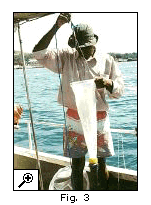|
|
 |
|
| |
 Initial studies of trace metals in organisms from Lake Tanganyika show that: Initial studies of trace metals in organisms from Lake Tanganyika show that:
Trace metal levels in whole milled clupeid fishes (Ndagala, dagaa or kapenta) are higher than those obtained from fillets of Lates; however both types of fish tested within the ranges that are safe for human consumption.
Molluscs had high levels of trace metals, indicating an increasing pollution problem. However, molluscs are not part of the local diet.

Finally, the PSS will convene a bilingual regional workshop next spring to create a pollution inventory for the lake. With the assistance of SS leaders and a facilitator, the group will design a questionnaire for the national teams to take to local industries near the lake. The questionnaire will determine the natures and quantities of effluents that they are emitting. A detailed inventory of industrial pollutants will be produced and distributed to environmental resource managers (Fig. 4).
|
|